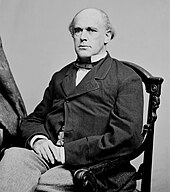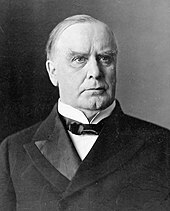| Revision as of 19:30, 16 June 2008 editGolbez (talk | contribs)Administrators66,917 editsm fix← Previous edit | Revision as of 19:31, 16 June 2008 edit undoGolbez (talk | contribs)Administrators66,917 edits loopbackNext edit → | ||
| Line 23: | Line 23: | ||
| |} | |} | ||
| The following is a '''list of Governors of the State of Ohio''' and the ] which preceded it. The ] is the head of the ] of ]'s government and the ] of the ] ] forces. The governor has a duty to enforce state laws; the power to either approve or ] ]s passed by the ]; the power to convene the legislature; and the power to grant ]s, except in cases of ] and ].{{ref|const-art3|}} | The following is a '''list of Governors of the State of Ohio''' and the ] which preceded it. The ] is the head of the ] of ]'s government and the ] of the ] ] forces. The governor has a duty to enforce state laws; the power to either approve or ] ]s passed by the ]; the power to convene the legislature; and the power to grant ]s, except in cases of ] and ].{{ref|const-art3|}} | ||
| The first constitution of 1802 allowed governors to serve for two years, limited to six of any eight years, commencing on the first Monday in the December following an election.{{ref|1802const-art2sec3|}} The current constitution of 1851 removed the ], and shifted the start of the term to the second Monday in January following an election.{{ref label|book-pp165166|C|1}} A 1957 amendment{{ref label|book-pp165166|C|2}} lengthened the term to four years and allowed governors to only succeed themselves once, having to wait four years after their second term in a row before being allowed to run again.{{ref|const-art3sec2|}} An ] ruling in 1973 clarified this to mean governors could theoretically serve unlimited terms, as long as they waited four years after every second term.{{ref label|book-pp165166|C|3}} | The first constitution of 1802 allowed governors to serve for two years, limited to six of any eight years, commencing on the first Monday in the December following an election.{{ref|1802const-art2sec3|}} The current constitution of 1851 removed the ], and shifted the start of the term to the second Monday in January following an election.{{ref label|book-pp165166|C|1}} A 1957 amendment{{ref label|book-pp165166|C|2}} lengthened the term to four years and allowed governors to only succeed themselves once, having to wait four years after their second term in a row before being allowed to run again.{{ref|const-art3sec2|}} An ] ruling in 1973 clarified this to mean governors could theoretically serve unlimited terms, as long as they waited four years after every second term.{{ref label|book-pp165166|C|3}} | ||
Revision as of 19:31, 16 June 2008
| Party | Governors |
|---|---|
| Republican | 29 |
| Democratic | 23 |
| Democratic-Republican | 8 |
| Whig | 5 |
| Federalist | 2 |
| National Republican | 1 |
The following is a list of Governors of the State of Ohio and the Northwest Territory which preceded it. The governor is the head of the executive branch of Ohio's government and the commander-in-chief of the state's military forces. The governor has a duty to enforce state laws; the power to either approve or veto bills passed by the Ohio Legislature; the power to convene the legislature; and the power to grant pardons, except in cases of treason and impeachment.
The first constitution of 1802 allowed governors to serve for two years, limited to six of any eight years, commencing on the first Monday in the December following an election. The current constitution of 1851 removed the term limit, and shifted the start of the term to the second Monday in January following an election. A 1957 amendment lengthened the term to four years and allowed governors to only succeed themselves once, having to wait four years after their second term in a row before being allowed to run again. An Ohio Supreme Court ruling in 1973 clarified this to mean governors could theoretically serve unlimited terms, as long as they waited four years after every second term.
Should the office of governor become vacant due to death, resignation, or conviction of impeachment, the lieutenant governor assumes the title of governor. Should the office of lieutenant governor also become vacant, the president of the state senate becomes the acting governor. If the vacancy of both offices took place during the first twenty months of the term, a special election is to be held on the next even-numbered year to elect new officers to serve out the current term. Prior to 1851, the speaker of the senate acted as governor for the term. Since 1974, the governor and lieutenant governor have been elected on the same ticket; prior to then, they could be (and often were) members of different parties.
There have been 62 governors of Ohio, serving 68 distinct terms. The longest term was held by Frank J. Lausche, who was elected five times and served just under ten years. The shortest terms were held by John William Brown and Nancy Hollister, who each served 11 days after the preceding governor them resigned; the shortest-serving elected governor was John M. Pattison, who died in office five months into his term. The current governor is Ted Strickland, who took office on January 8 2007.
Governors









Initially after the American Revolution, parts of the area now known as Ohio were claimed by New York, Virginia, and Connecticut; however, New York ceded its claim in 1782, Virginia in 1784, and Connecticut in 1786, though it maintained its Western Reserve in the area until 1800. On July 13, 1787, the Northwest Territory was formed. As territories were split from it, it eventually came to represent just present-day Ohio.
Governor of Northwest Territory
Throughout its 15-year history, Northwest Territory had only one governor. There was no Ohio Territory; Ohio is considered the successor state to the Northwest Territory.
| # | Picture | Governor | Appointed | Left office | Party | Appointed by |
|---|---|---|---|---|---|---|
| 1 | 
|
Arthur St. Clair | October 5 1787 | November 22 1802 | None | Continental Congress |
Governors of Ohio
Ohio was admitted to the Union on March 1 1803. Since then, it has had 62 governors, six of whom served non-consecutive terms.
Democratic-Republican Federalist National Republican Democratic Whig Republican
Notes
- Table includes non-consecutive terms, and only includes state governors.
- St. Clair was appointed governor by the Continental Congress; being governor of the first territory of the United States, he predated presidential appointments (and indeed the presidency itself).
- The office of lieutenant governor was not created until the 1851 Constitution, first being filled in 1852.
- The fractional terms of some governors are not to be understood absolutely literally; rather, they are meant to show single terms during which multiple governors served, due to resignations, deaths and the like.
- ^ Resigned to take an elected seat in the United States Senate.
- ^ As speaker of the state senate, acted as governor for unexpired term.
- The 1808 election was actually won by Return J. Meigs, Jr., but he was declared ineligible for office for failing the residency requirements.
- Resigned to be U.S. Postmaster General.
- Resigned to be Minister to Mexico.
- ^ William Bebb's term officially ended in December 1848. However, due to the large number of close elections that year, the general assembly was delayed in qualifying governor-elect Seabury Ford, and William Bebb remained in office for an extra few weeks.
- Wood's first term was truncated to one year, due to the 1851 constitution moving elections one year back to odd-numbered years.
- Resigned to be consul in Valparaíso, Chile.
- As lieutenant governor, filled unexpired term, and was later elected in his own right.
- ^ Died in office.
- ^ As lieutenant governor, filled unexpired term.
- Resigned to be President of the United States.
- ^ A 1905 amendment to the state constitution shifted elections forward one year, to take place on even years; thus, Pattison's term (completed by Lt. Governor Harris) was extended to three years.
- Governor Strickland's first term expires on January 10 2011; he is not yet term limited.
Other high offices held
This is a table of other governorships, congressional and other federal offices, and ranking diplomatic positions in foreign countries held by Ohio governors. All representatives and senators mentioned represented Ohio. * denotes those offices which the governor resigned to take. † denotes those offices from which the governor resigned to take the governorship.
Living former governors
As of June 2008, five former governors were alive, the oldest being John J. Gilligan (1971–1975, born 1921). The most recent governor to die was Jim Rhodes (1963–1971 and 1975–1983), on March 4 2001.
| Name | Gubernatorial term | Date of birth |
|---|---|---|
| John J. Gilligan | 1971–1975 | March 22 1921 |
| Dick Celeste | 1983–1991 | November 11 1937 |
| George Voinovich | 1991–1998 | July 15 1936 |
| Nancy Hollister | 1998–1999 | May 22 1949 |
| Bob Taft | 1999–2007 | January 8 1942 |
See also
References
- General
- "Governors Database: Ohio". National Governors Association. National Governors Association. 2008. Retrieved 2008-05-18.
- "Ohio Governors". Ohio Public Library Information Network. Retrieved 2008-06-04.
- "The Governors of Ohio, 1803–1971". Ohio Historical Society. 1969. Retrieved 2008-05-30.
- Steinglass, Steven H. (2004). The Ohio State Constitution: A Reference Guide. Greenwood Publishing Group. ISBN 0313267650. Retrieved 2008-05-30.
{{cite book}}: Unknown parameter|coauthors=ignored (|author=suggested) (help) - "Lieutenant Governors of the State of Ohio: 1852 - present". Ohio Secretary of State. Retrieved 2008-06-04.
- Constitutions
- "Constitution of the State of Ohio". Ohio General Assembly. 1851. Retrieved 2008-05-29.
- "Constitution of the State of Ohio". Ohio Historical Society. 1802. Retrieved 2008-05-29.
- Specific
- OH Const. art. III.
- 1802 Const. Art II, § 3.
- Steinglass, pp. 165–166
- OH Const. art. III, § 2.
- OH Const. art. III, § 15.
- OH Const. art. III, § 17.
- 1802 Const. Art II, § 12.
- Steinglass, p. 164
- "Ownership of the Northwest". Heritage Pursuit. Retrieved 2008-06-16.
- "Evolution of Territories and States from the Old "Northwest Territory"". Retrieved 2008-06-16.
- "History of Cincinnati and Hamilton County". Heritage Pursuit. Retrieved 2008-05-30.
- Steinglass, p. 7
- "Andrew L. Harris". Ohio Historical Society. Retrieved 2008-05-30.
- "Governors Database: Ohio". National Governors Association. National Governors Association. 2008. Retrieved 2008-05-30.
- "MEIGS, Return Jonathan, Jr". Biographical Directory of the United States Congress. Retrieved 2008-05-30.
- "WORTHINGTON, Thomas". Biographical Directory of the United States Congress. Retrieved 2008-05-30.
- "COX, James Middleton". Biographical Directory of the United States Congress. Retrieved 2008-05-30.
- "WILLIS, Frank Bartlett". Biographical Directory of the United States Congress. Retrieved 2008-05-30.